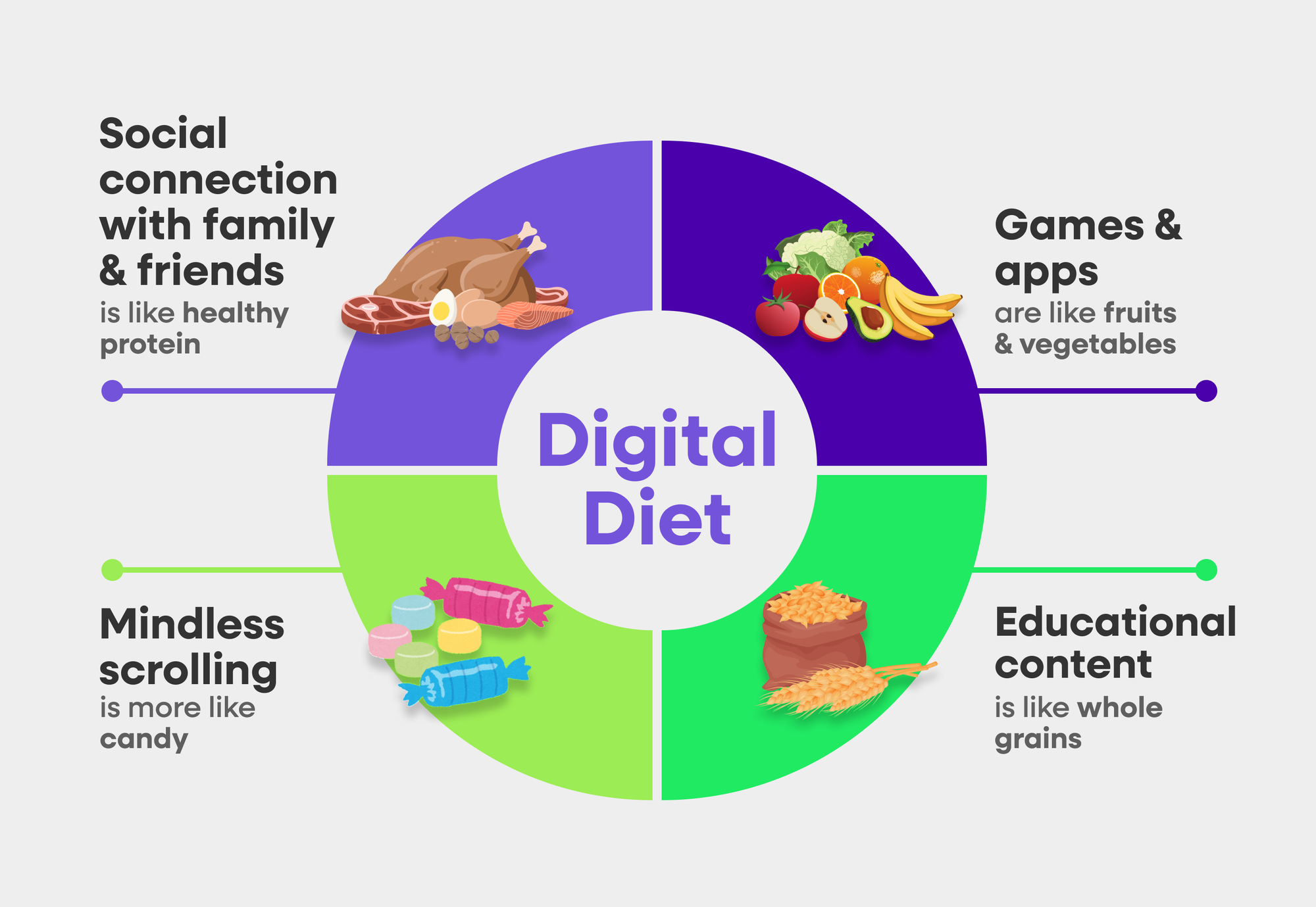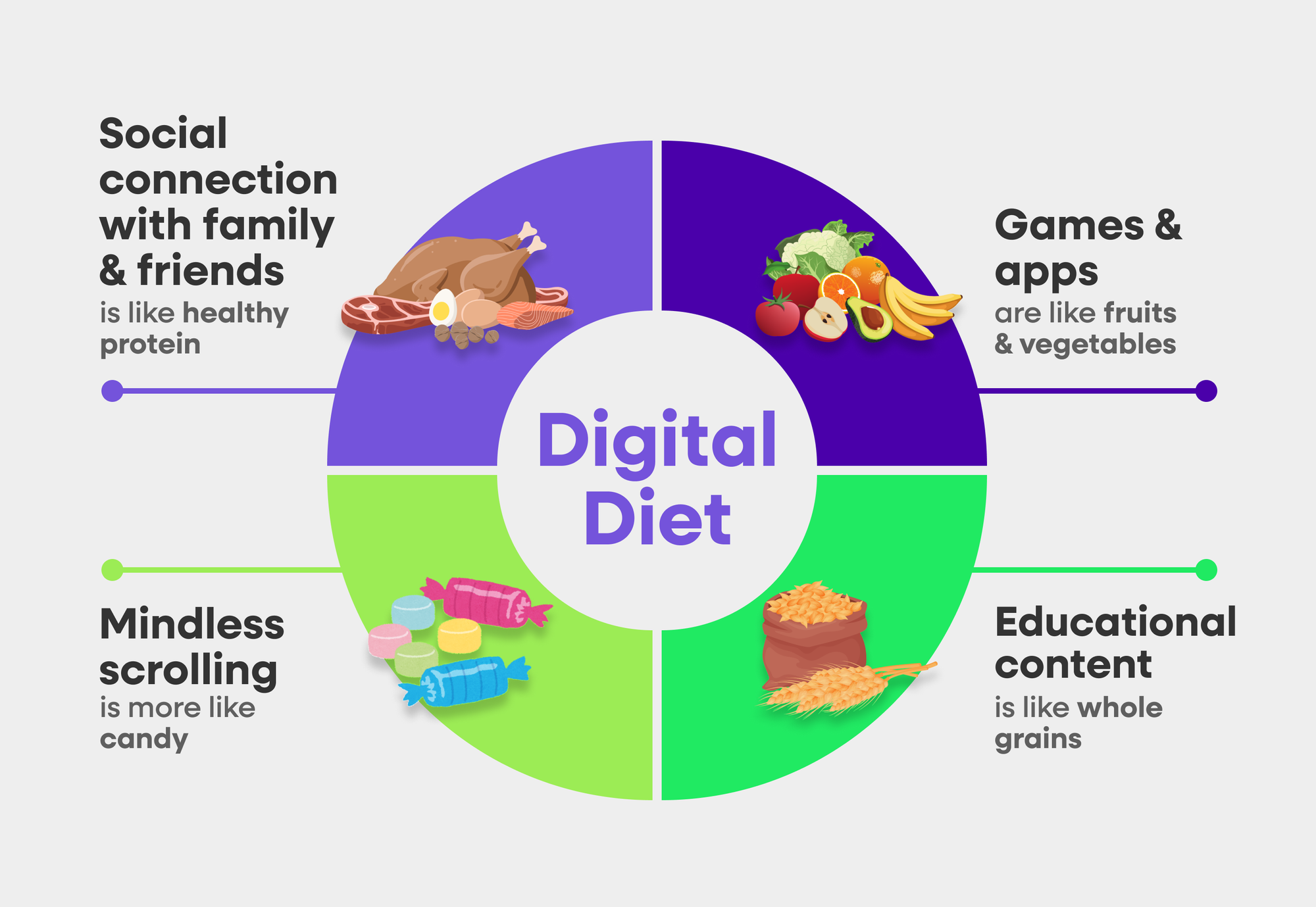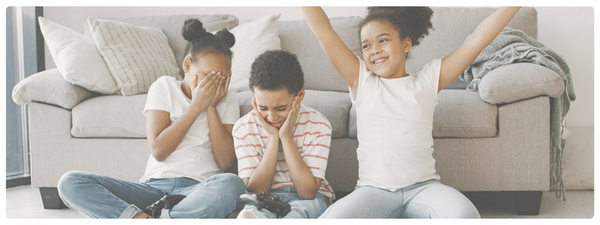Headlines about screen time for kids can be scary. Parents often hear that screens are destroying childhood, damaging developing brains, or creating a generation of overweight and uninspired kids. However, research tells a more encouraging story about how screens can support learning and development when thoughtfully used.
Key Takeaways: Kids' Screen Time
Research shows:
- Screens are tools, not enemies: Digital technology can help children connect, learn, and develop essential skills
- Quality over quantity: Studies indicate that what children do on screens matters more than counting minutes
- Brain development stays healthy: Research finds no evidence that typical screen use causes developmental harm
- Mental wellbeing remains stable: An Oxford study of 350,000 adolescents found technology explains just 0.4% of wellbeing differences
- Three factors make the difference: Content, context, and communication
Types of Screen Time: How to Build a Balanced Digital Diet
Just like nutrition, screen time for kids is about quality rather than just quantity. Think of digital activities as items in a balanced diet:

- Learning games and creative apps are like fruits and vegetables
- Social connection through video chats is like healthy protein
- Passive video watching is more like candy — fine in moderation
- Educational content is like whole grains — nutritious building blocks
Everyone's "digital diet" looks different. Some children may thrive with more creative apps, while others benefit most from social connection tools. The key is mindfully choosing screen time activities for kids that add value rather than just counting "calories" or minutes.
What Counts as “Screen Time”?
Screen time is truly a catch-all word that simply refers to any screen-based activity. Interacting with a mobile phone, tablet, television, computer, gaming console, and anything else with a digital screen is screen time.
- Reading this article on a digital device is screen time.
- Using screens for work, school, or other collaborations is screen time.
- Scrolling social media, video chatting, gaming, and watching shows or movies is screen time.
- Doing artwork, coding, writing, or other creative endeavors on a screen is screen time.
Since so many activities have migrated to screens, it’s easy to see screen time popping up in the lives of parents and children. As such, it is important to start thinking about the quality of the screen time rather than the quantity.
Reading this article on a screen is screen time — but it is also just as much reading time, educational time, and perhaps even leisure time (for my fellow science nerds out there).
Active vs Passive Screen Time: Why It Matters
Not all screen time is the same, as the digital diet explains. Screen time can generally be bucketed into two categories: active and passive. The distinction between these two types can help us better understand the role of screens in our lives and also help us make more informed decisions about our children’s digital habits.
Active screen time is any screen-based activity where we are actively thinking, creating, or communicating rather than more passively consuming content. Some examples of active screen time include:
- Playing video games (some of my current family favorites are Minecraft and Lego Fortnite)
- Engaging in a virtual art lesson or interactive science experiment
- Video chatting with family members
- Collaborating on a group project
- Playing movement-based games that encourage physical activity (such as Pokemon Go)
Active screen time is typically seen as more valuable than passive screen time, as it is more likely to support cognitive development, fine motor skills, and social-emotional learning, among other things. When we use screens in ways that actively challenge our thinking or encourage creativity, technology can be utilized as a tool for growth rather than distraction.
Passive screen time is any screen-based activity in which we are not actively participating. Passive screen time is often more about entertainment and distraction than active learning or engagement. Some examples of passive screen time include:
- Watching TV shows, videos, or movies
- Live-streaming services such as YouTube or Twitch
- Scrolling social media feeds
It is important to reiterate that passive screen time is not inherently bad. There is value in relaxing with a movie or catching up on your friend’s vacation photos on social media.
Where we start to see concern from parents is when passive screen time starts to infringe on a child’s opportunities to be bored. Boredom is often the impetus for kids to use their imagination and creativity, but if this boredom is consistently placated by passive screen time, we may be missing some of those opportunities.
Thinking back to the digital diet, achieving quality over quantity means having a greater dose of active than passive screen time.
Teaching ourselves and our children how to identify and balance active versus passive screen time will help us all build more thoughtful relationships with digital media.
Effects of Screen Time on Children: What Research Studies Reveal
Parents can breathe easier knowing that screens aren't stealing their children. Studies examining technology use over decades show predominantly positive impacts when used thoughtfully.
In fact, children lacking digital access face increasing disadvantages in developing critical skills - what UNICEF calls a "digital canyon" in educational opportunity.
Effects of Screen Time on Kids' Physical Activity
A natural worry is that screen time means less outdoor play. The good news? Research shows no consistent link between screen use and reduced physical activity. In fact, studies find these behaviors are independent - kids who love their tablets can also love the playground, and this pattern holds true as children grow.
Effects of Screen Time on Kids' Mental Health
What about psychological effects? The research is reassuring. That landmark Oxford study of 350,000 adolescents found technology use itself explains less than half a percent of wellbeing differences. While content matters - cyberbullying and inappropriate material are real concerns - the mere presence of screens in children's lives isn't driving negative mental health impacts.
“Better” Screen Time: Digital Play for Meaningful Engagement
While traditional play is universally valued, digital play often gets dismissed as "lesser." But research shows play is play, whether it's building with blocks or building in Minecraft. Games like Tetris develop spatial skills and can even teach broader life lessons. Even watching musical videos on YouTube teaches rhythm, language, and early reading skills when words appear on screen.
Screen Time Research: Canadian Paediatric Society (CPS)
A 2022 study by the CPS (Screen time and preschool children: Promoting health and development in a digital world) highlights the positive impacts screen time can have on children. It found that when used in moderation and under parental guidance, screen time can have significant learning and development benefits. Video chats, educational games, and other similar content were found to support language, literacy, and social skills.
So-called “passive” screen time was also found to have significant positive effects. Notably, both academic and life skills were highlighted as potential areas for growth that can be facilitated by screen-based activities, from math skills to problem-solving to developing empathy.
By prioritizing active engagement (and setting proper boundaries), parents can support healthy digital parenting.
Screen Time Research: International Journal of Behavioral Nutrition and Physical Activity
A 2019 study further challenges the idea that all screen time is harmful. Instead, it highlights that content type matters more than total screen time when considering its impact on children’s development.
For example, educational screen time, such as using a computer for homework, was linked to better academic performance and persistence, with no negative effects on physical or psychological health. Interactive screen time, like video games, was found to support learning outcomes.
Generally speaking, passive screen time was associated with poorer outcomes — but it’s worth noting these effects were very small. Taken together, this research reinforces the importance of quality over quantity in digital engagement.
By prioritizing educational and interactive content, parents can support healthy screen habits that encourage learning and development without unnecessary restrictions.
The Three C's of Screen Time: A Research-Backed Framework
How can parents maximize benefits of screen time for their kids, while minimizing potential harms? Research points to three key factors - what's become known as the Three C's: Content, Context, and Communication.
Content: Choosing Age-Appropriate Material
Just like other aspects of childhood, digital content needs to match developmental stages. Content can range from FaceTime with grandparents to educational games to creative apps. The key is ensuring it's developmentally appropriate and purposeful.
Helpful resources include:

- Entertainment Software Ratings Board (ESRB) ratings:
- E for Everyone
- Everyone 10+
- Teen
- Mature (17+)
- Adults Only (18+)
- Pan-European Game Information (PEGI) for international families
- Common Sense Media Reviews for detailed content analysis
Context: Understanding the "Why"
Context is the "mood music" of screen time. Is that tablet time about:
- Connecting with far-away family?
- Learning new concepts?
- Creative expression?
- Taking a needed break?
Keep in mind, all these are be valid contexts. Understanding why a child is engaging with screens often matters more than what they're watching or playing.
Communication: Keeping Dialogue Open
While content choices matter, and context is crucial, communication proves most important for positive outcomes. Open dialogue helps children:
- Navigate online spaces safely
- Develop self-regulation
- Make thoughtful choices
- Build digital literacy
- Understand family boundaries
Talking to children about their screen time is key to making and solidifying lasting connections.
Managing Screen Time Transitions: The Donut Principle
Even with quality content and clear context, transitions away from screens can be challenging. Here's a helpful analogy: Imagine eating a delicious donut - perhaps an apple fritter with the perfect glaze. You're savoring each bite when suddenly, someone snatches it away mid-bite. Frustrating, right?
The same principle applies to screen time. When children are engaged in an activity - whether it's a game, video, or creative app - abrupt transitions can feel just as jarring. Instead of sudden stops, try scaffolding:
- Give clear time warnings (15 minutes, 10 minutes, 5 minutes)
- Use visual timers when possible
- Help children find natural stopping points
- Acknowledge that transitions take practice
Remember that self-regulation is a learned skill. Using scaffolding techniques helps children develop these abilities gradually, without making screen time tense.
Screen Time Pros and Cons
With all this information to take in around better screen time for children, it helps to summarize the pros (positives) and cons (negatives). While every child, parent, and form of media is different, these benefits and challenges are a solid guide for approaching your own screen time decisions.
Pros of Screen Time
Research proves that screen time can support healthy growth and development in children when used correctly. The benefits of active, engaging, and properly managed “better” screen time include:
- Academic skill development, such as reading, math, history, social studies, computers, and science
- Life skill development, such as problem-solving, resilience, resourcefulness, and emotional management
- Creativity and self-expression through digital art, music production, storytelling, video games, and coding projects
- Social connection through video chats with family, collaborative games, and shared online experiences
- Physical and mental well-being, with interactive fitness apps, movement-based games, and mindfulness tools
- Digital literacy by safely navigating technology, evaluating information, and making screen time decisions
When screen use is intentional rather than purely for entertainment, these positives are amplified.
Cons of Screen Time
Studies on screen time show it can also present challenges to developing healthy, smart, and emotionally regulated children. Some of the downsides, especially with the overuse of passive options, can include:
- Sleep disruption caused by screen use too close to bedtime
- Reduced physical activity, if screen time crowds out opportunity for more physical play and interaction
- Harmful content exposure, when screen time is not monitored or safeguarded with parental controls
- Overstimulation or inattention, especially when exposed to highly stimulating content
- Difficulty managing screen use since children may feel drawn to screens to soothe, entertain, and occupy
It’s all about balance. Active screen time choices can offset the impacts of general screen use, as can reducing passive screen time in general. Finding positives and negatives about screen time for children depends much more on quality than quantity.
To embrace the pros and avoid the cons, it’s critically important to:
- Mix digital activities with non-digital activities
- Maintain open communication about screens and content
- Build healthy relationships — with parents/kids and devices
- Encourage reflecting on screen time — what did they learn?
Finding opportunities to embrace better screen time options will give parents peace of mind and also help to prioritize active rather than passive engagement.
Empowering Parents and Kids with Balanced Screen Time
Screen time for children in the 21st century isn't optional, it's a necessary tool for learning, connection, and development. While challenges exist — from managing transitions to choosing appropriate content — research shows the impact of screens on kids is largely positive when approached thoughtfully.
Parents struggling with screen time aren't alone. The key isn't perfect management but rather thoughtful integration. Families can help children develop healthy relationships with technology that supports rather than hinders their growth by:
- Focusing on quality over quantity
- Understanding context
- Maintaining open communication
Just as we teach children to make healthy food choices rather than counting every calorie, we can guide them toward meaningful and engaging screen time rather than counting every minute.
The goal isn't restriction but rather empowerment: helping children build the skills they need to navigate our digital world with intention and balance.
Discover Nurture's approach to teaching life skills through digital play (a type of active screen time).
Nurture Academy FAQ: Screen Time for Kids
Provided by Nurture
How much screen time is too much for young kids?
There’s no magic number. For kids ages 4–7, many pediatric groups recommend around 1 hour of recreational screen time per day — but the bigger priority is quality and balance. Ask: What are they doing on screens? Is it crowding out sleep, movement, or connection? That tells you more than the clock.
Is screen time bad for brain development?
Not when it’s used thoughtfully. Research has consistently shown that typical screen use — especially when interactive, creative, or educational, does not harm children’s brain development. In fact, some forms of digital play support language growth, problem-solving, and fine motor skills.
What’s the difference between active and passive screen time?
Active screen time includes activities where kids think, create, or connect — like building in Minecraft, drawing on a tablet, or FaceTiming grandparents. Passive screen time is more about watching or scrolling. Both can be part of a healthy routine, but too much passive time can edge out opportunities for boredom, movement, or reflection.
Can screen time impact physical or mental health?
The link isn’t as strong as you might think. Large-scale studies show that screens aren’t inherently harmful. Instead, it’s how they’re used, and whether they displace important activities like sleep, physical play, or face-to-face connection. With intention and variety, screen time can support both body and mind.
What’s the best way to build healthy screen habits for kids?
Focus on Dr. Rachel Kowert's “Three Cs”:
- Content: Is it age-appropriate, enriching, or creative?
- Context: Why are they using the screen? What else is going on?
- Communication: Are you talking with your child about what they’re doing and how it makes them feel?
When these three factors are in place, screens become a tool for learning and connection — not just entertainment.
For more, head to the FAQ on the impacts of screen time on kids.





 Copy Link
Copy Link
 Share
to X
Share
to X
 Share
to Facebook
Share
to Facebook
 Share
to LinkedIn
Share
to LinkedIn
 Share
on Email
Share
on Email




